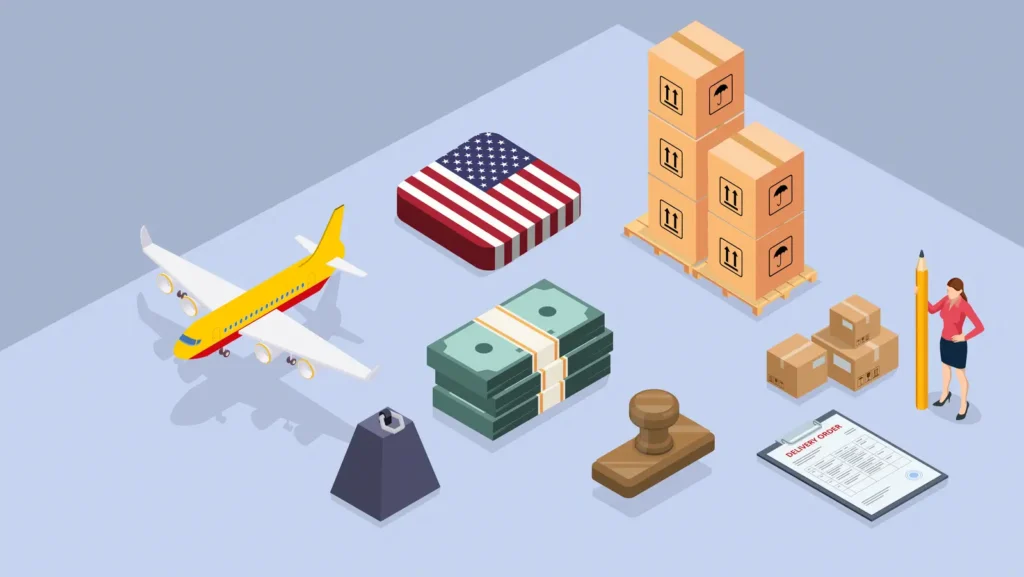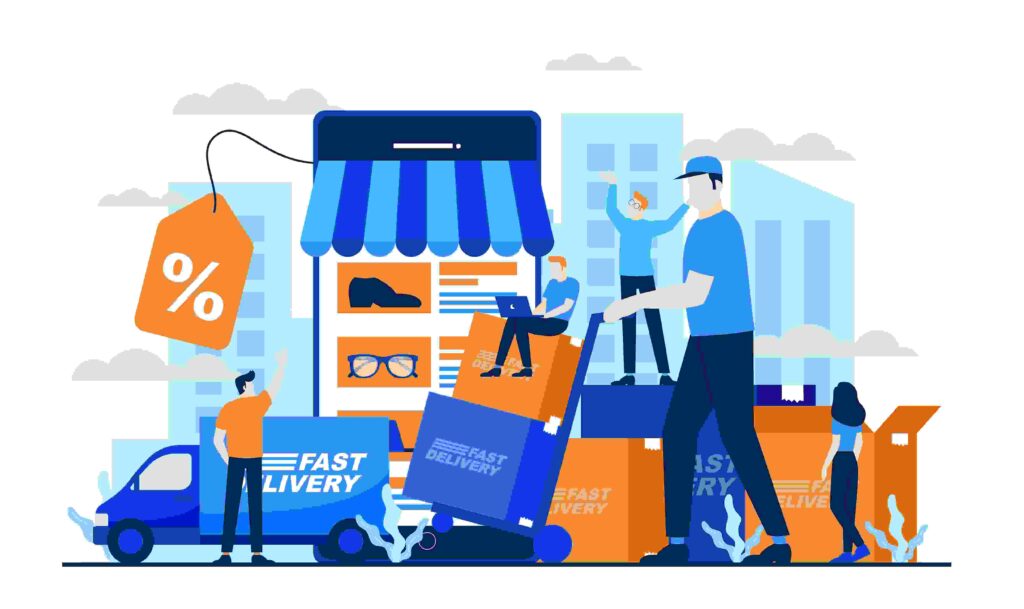In recent months, the term “De Minimis Removal” has become a hot topic in the global e-commerce community especially among those running Print on Demand (POD) businesses targeting the U.S. market. The potential elimination of the De Minimis Rule, which currently exempts imported goods under $800 USD from customs duties, could mark a major turning point, directly impacting the operational models of tens of thousands of international sellers including the Vietnamese POD community.
From logistics costs and import taxes to sample testing and product scaling, every link in the POD supply chain could be affected. This article will help you understand what De Minimis Removal is, why it has been proposed, how it specifically impacts sellers and the global POD market, and provide strategic solutions to help you adapt effectively in this changing landscape.

What Is De Minimis Removal?
If you’re an e-commerce seller, especially in the Print on Demand (POD) or dropshipping sectors targeting the U.S. market, “De Minimis Removal” is one of the most critical terms you need to understand right now. This is not just a minor policy tweak; it’s a potential regulatory shift that could reshape the entire supply chain and profit margins across the industry.
What Does “De Minimis” Mean?
Before understanding the term “Removal,” we first need to define “De Minimis.”
“De minimis” is a Latin phrase meaning “about things too small to be considered.” In the context of international trade, it refers to a threshold value below which imported goods are considered “too minor to warrant attention.”
In the United States, this concept is most clearly defined under Section 321 of the U.S. Customs law (19 U.S.C. §1321(a)(2)(C)). For many years, this rule has allowed shipments with a retail value under $800 (per person, per day) to be imported duty-free, with only minimal customs clearance procedures.
This provision has essentially served as the “golden ticket” behind the boom of cross-border e-commerce, enabling millions of small parcels to be shipped directly from countries like China and Vietnam to U.S. consumers at extremely low costs.
So, What Is De Minimis Removal?
Simply put, De Minimis Removal refers to the legal action of eliminating or significantly restricting the $800 duty-free privilege for imported goods.
It encompasses a series of legislative and executive measures by the U.S. government aimed at ending tax exemptions for low-value shipments. Under recent policy changes for instance, an executive order effective from August 29, 2025 the duty-free benefit for goods under the de minimis threshold has been officially revoked.
In short, “De Minimis Removal” means that whether your shipment is worth $25 or $250, it will no longer be tax-exempt when entering the U.S. Every package will now be subject to import duties and full customs inspections, just like large commercial shipments.
This shift transforms what were once “lightweight” and low-cost parcels into shipments burdened by higher taxes, fees, and more complex clearance procedures.
Why Did the De Minimis Removal Proposal Emerge?

The $800 duty-free rule (De Minimis) was once the “fast lane” for global e-commerce and POD businesses entering the U.S. market. It allowed goods to be shipped quickly and cheaply without the burden of customs duties. However, that “golden era” is now coming to an end.
The U.S. government’s decision to take action culminating in the Executive Order issued on July 30, 2025, which declared the “suspension of low-value de minimis exemptions” was not a random move. It was the result of a “perfect storm” created by four major pressures.
The “Tsunami” of Packages and Customs Overload
The most obvious reason is the uncontrolled explosion of low-value imports. The scale of this issue is staggering: According to official data, the number of de minimis shipments imported into the U.S. in 2024 reached approximately 1.36 billion parcels, compared to just 134 million in 2015.
This exponential surge has placed immense pressure on the U.S. Customs and Border Protection (CBP). With billions of small parcels entering the country, it has become virtually impossible to inspect or screen each one for violations. The customs system simply wasn’t built to handle this flood of goods, creating significant oversight and enforcement gaps.
Security Risks and Tax Evasion
When control is lost, loopholes are inevitably exploited. The $800 de minimis threshold has unintentionally become a convenient channel for smuggling prohibited goods, counterfeit products, and evading import taxes.
U.S. government agencies have raised serious national security concerns. According to the Department of Homeland Security (DHS), up to 98% of narcotics (particularly fentanyl) seized from shipments originated from de minimis parcels. Moreover, counterfeit, unsafe, and substandard goods have easily slipped through customs by being split into multiple small-value shipments.
Unfair Competition and Domestic Industry Protection
This is the core economic reason behind the policy change. While U.S. manufacturers and retailers are required to comply with labor laws, safety standards, and pay full import duties on raw materials, foreign competitors have enjoyed complete tax exemptions on identical products thanks to the de minimis rule.
This has created an uneven playing field. Domestic producers simply cannot compete on price with tax-free imported goods. Therefore, the removal of the de minimis exemption is viewed as a strategic measure to protect U.S. manufacturing and restore fair market competition.
Decisive Political Action
Given these three factors, political intervention was inevitable. The Executive Order issued on July 30, 2025, which suspended the de minimis exemption, marked the first decisive move.
In addition, proposed legislation such as the “One Big Beautiful Bill Act” is now being advanced, aiming to permanently eliminate the de minimis privilege starting July 1, 2027.
In Summary
De Minimis Removal represents an irreversible strategic shift, driven by system overload, serious security risks, and domestic economic protection pressures.
Specific Impacts on the Print on Demand (POD) Model

For sellers operating under the Print on Demand (POD) model, where products are printed or produced per order, usually lightweight, compact, and shipped directly to customers the elimination or tightening of the de minimis threshold could have significant consequences. However, the extent of the impact will vary greatly depending on the fulfillment model that Vietnamese sellers are currently using.
For Vietnamese Sellers Using International Fulfillment (from China, Vietnam, etc.)
If your POD business depends on platforms or suppliers with production facilities located outside the U.S. such as in China, Vietnam, Spain, or any other country to ship directly to American customers, you are among the most directly, heavily, and negatively affected groups by the De Minimis Removal policy.
The cross-border model, which has long relied on the $800 duty-free advantage, is now coming to an end. Let’s analyze the worst-case scenario when this exemption is completely removed.
Cost Explosion – Profit Margins Vanish
This is a direct financial blow. Consider a simple example:
- Before: A hoodie costs $25 (base + shipping) this is your total cost.
- After De Minimis Removal: New total cost = $25 (base cost) + $X (import duty) + $Y (customs handling fee)
Import duties for apparel entering the U.S. are typically 16.5% to 32%. Assuming an average rate of 20%, your cost immediately increases by $5 in taxes ($25 × 20%).
In addition, each parcel will incur fixed customs handling fees of around $3–$5.
As a result, your total cost rises from $25 to $33–$35, meaning your profit margin is almost completely wiped out.
Massive Shipping Delays
The “fast lane” customs clearance has disappeared. Now, every parcel must be held at the border for inspection and tax processing. The previous 7–12 day delivery time will become a thing of the past.
Instead, sellers will face 15–25+ day delivery times. U.S. customers, who are accustomed to Amazon’s speed, will not accept this delay. Consequently, sellers will face a sharp increase in order cancellations, refund requests (chargebacks), and negative reviews.
Customer Experience (CX) Collapse
The worst-case scenario and a potential death blow for any e-commerce store is DDU (Delivery Duty Unpaid). In this case, the parcel is held at customs, and the customer receives a notice requiring them to pay additional taxes to receive their order.
This creates the worst possible customer experience, where buyers feel deceived, frustrated, and unlikely to ever return to your store.
For Sellers Using U.S. Domestic Fulfillment
In complete contrast to the international fulfillment model, De Minimis Removal is actually a highly positive development for Vietnamese sellers who are already using U.S.-based fulfillment services.
If you belong to this group the professional sellers partnering with fulfillment providers (such as FlashShip) that operate warehouses and print facilities within the United States you are holding a “golden position.” This is not a crisis; for you, it is a once-in-a-lifetime opportunity to grow and dominate the market.
A Level Playing Field: The Price War Is Over
The core, and almost the only, competitive advantage of China-based fulfillment has been low prices made possible by completely bypassing the $800 import tax threshold. Once this tax exemption disappears, the rules of the game change entirely.
Print facilities in China shipping to the U.S. must now add 20–30% in extra costs (including import duties and customs handling fees) to their base price. Instantly, their previously lower base cost becomes equal to or even higher than that of U.S.-based fulfillment.
As a result, the price war that domestic sellers have long struggled to endure has officially come to an end.
Speed Becomes the Ultimate Weapon
U.S. domestic fulfillment has always held a clear advantage in speed, with shipping times of just 2–5 days. But in this new landscape, that advantage reaches an entirely new level.
As international fulfillment faces 15–25+ day customs delays, your 2–5 day delivery speed is no longer just an advantage it becomes the ultimate weapon to win customers. In an era when U.S. consumers are accustomed to Amazon Prime-level delivery, they will naturally prioritize stores that guarantee “Fast U.S. Shipping.”
The Power of Trust: “Shipped from USA”
American customers are increasingly frustrated with slow deliveries, unclear origins, and the risk of low-quality goods. The De Minimis Removal is the final trigger that pushes them to seek more reliable options.
Now, the ability to advertise “Shipped from USA” or “Printed in the USA” has become an extremely powerful selling point. It’s not just a promise of speed it’s a symbol of quality, reliability, and transparency. This helps you build stronger customer trust, reduce order cancellations and returns, and enhance your brand value significantly.
Full Immunity from Policy Changes
Most importantly, because your products are produced and shipped entirely within the U.S., your business is 100% immune to any changes in import tax policies or future adjustments related to De Minimis thresholds or tariffs.
For the Overall POD Market
Market Consolidation
A major market shakeout is inevitable. Small or amateur sellers those who rely solely on the cheapest Chinese suppliers and short-term “hit-and-run” selling tactics will be the first to be eliminated.
The market will consolidate in favor of professional sellers with clear strategies, sustainable operations, and partnerships with reputable fulfillment platforms.
Supply Chain Shift
A massive migration wave within the industry is expected, as sellers begin shifting from China-based fulfillment platforms to U.S. domestic fulfillment providers.
Domestic fulfillment platforms will experience rapid expansion, while those dependent solely on Chinese manufacturing will face a severe downturn or potential crisis.
Increase in Average Retail Prices
With the duty-free advantage removed, the overall price floor for POD products in the U.S. market will rise.
However, this is not necessarily a negative outcome. It allows professional sellers to maintain healthier profit margins, reinvest in design, branding, and marketing, and move away from the destructive price war that has long plagued the POD industry.
Solutions and Adaptation Strategies for POD Sellers

Recognizing the risks is only the first step taking action is what truly matters. Below are five survival strategies every POD seller should implement immediately.
Don’t Panic – Conduct an Immediate Audit
First, don’t panic. Major policy changes in the U.S. often take time to debate and fully implement. However, this is not the moment to be complacent either.
The very first step is to audit your supply chain:
- Open your list of suppliers or platforms.
- Ask yourself: “Where are my orders being fulfilled from?” (The U.S., China, the EU, or Vietnam?)
- If the answer is “China” or “International,” ask the next question: “Am I 100% dependent on this supplier?”
- Contact their support team and ask directly: “What is your contingency plan for the De Minimis Removal?”
If they cannot provide a clear and confident answer, that is a major red flag – a warning sign that you may need to diversify your fulfillment sources immediately.
Core Strategy: Diversify into U.S. Domestic Fulfillment
This is the most important, safest, and most sustainable solution. Never put all your eggs in one basket.
- Start now even if it’s just a test: Even if your current China-based fulfillment is still profitable, you should immediately start partnering with a U.S. domestic fulfillment provider (for example, services offered or recommended by FlashShip).
- Migrate your best-sellers first: Begin by moving one or two of your top-performing products (winning campaigns) to a domestic fulfillment partner.
- Accept the initial cost difference: It’s true that U.S. base costs may currently be $1–$2 higher than those from China. But think of that extra cost as insurance for your business protection against the risk of your entire operation collapsing once the De Minimis rule is removed.
- Once you become familiar with the workflow and operations, you’ll be ready to flip the switch and move 100% of your orders to domestic fulfillment whenever necessary.
Level Up the Game: Build a Brand, Not Just Sell T-Shirts
The era of “hit and run” selling relying on low prices and exploiting loopholes is coming to an end. The future of POD belongs to brands.
Why does branding matter?
When everyone’s base cost becomes equal (as China-based fulfillment loses its advantage), the competition will no longer be about price. It will be about:
- Whose designs are more unique?
- Whose community is stronger?
- Whose customer service is better?
- Whose brand story is more compelling?
Action steps:
- Invest in high-quality, niche-focused designs.
- Build and nurture your email list and customer relationships.
- Create a professional Shopify or WooCommerce store instead of relying solely on marketplaces.
- Focus on perceived value, so you can sell at a higher price, not the cheapest one.
Diversify Your Markets (Don’t Sell Only in the U.S.)
The U.S. is the largest market, but it is also one of the most politically volatile. If your business depends 100% on U.S. sales, you are taking a high-risk bet.
Explore other markets such as the EU, United Kingdom (UK), Australia (AU), and Canada. Keep in mind that each market has its own tax regulations. For example, the EU has already removed the De Minimis threshold and requires sellers to register for IOSS to collect VAT on all orders. This means you need a fulfillment partner experienced with IOSS compliance in the EU.
Look for fulfillment providers with global networks and print facilities in key markets (U.S., EU, AU, etc.). This allows you to localize your operations wherever you sell.
Optimize Costs and Operational Efficiency
As profit margins tighten (due to the loss of De Minimis advantages or higher base costs), cost control becomes critical.
- Track key metrics closely: Know your profit per order, ad spend, and conversion rate (CR) with precision.
- Work with reliable partners: A good fulfillment provider is not just a printing facility. They should be a technology-driven partner that helps you automate orders, reduce errors, and speed up fulfillment.
- Use stable payment gateways: Ensure your cash flow remains healthy so you can maintain liquidity and quickly adapt to changing cost structures.
The implementation of De Minimis Removal is not merely a change in trade policy it is also a wake-up call for the Vietnamese POD seller community about the importance of proactive adaptation and business restructuring. From recalculating costs and optimizing operational chains to partnering with U.S.-based fulfillment providers, every strategic move in the right direction will help you maintain profitability and ensure a steady order flow.
In this new landscape, agility and responsiveness will determine who survives and who leads.
If you are looking for a U.S-standard fulfillment partner with production starting from just 1 business day and domestic shipping within 2–5 days, let FlashShip be your trusted companion.
Contact us today at (+84) 943 024 337 or visit FlashShip.net for detailed consultation, instant quotations, and tailored fulfillment strategies that empower Vietnamese sellers to confidently conquer the U.S. POD market in this new era.

